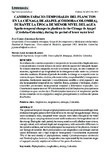Cambios espacio-temporales del plancton en la ciénaga de Aayapel (Córdoba-Colombia), durante la época de menor nivel del agua
Spatio-temporal changes in plankton in the ciénaga de Ayapel (Córdoba-Colombia), during the period of lower water level
Compartir este ítem
Fecha
2012Autor
Jaramillo-Londoño, Juan Carlos
Aguirre-Ramírez, Néstor Jaime
Jaramillo-Londoño, Juan Carlos; Universidad de Medellín; Universidad de Antioquia
Aguirre-Ramírez, Néstor Jaime; Universidad de Antioquia
Citación
Metadatos
Mostrar el registro completo del ítemDocumentos PDF
Resumen
Se evaluaron los cambios espaciales y temporales de los ensambles fitoplanctónicos y zooplanctónicos durante la época de menor nivel de agua en la Ciénaga de Ayapel. Se tomaron muestras integradas en toda la columna de agua, en seis estaciones de muestreo, siguiendo el eje longitudinal de la ciénaga en sentido norte-sur, y durante siete días continuos. Durante el período de estudio la ciénaga se comportó como un sistema de aguas blandas, alcalino, altamente turbio, con profundidad y transparencia reducidas, fuertemente mezclado y con diferencias notables a nivel espacial y una alta homogeneidad temporal de sus variables físicas, químicas y biológicas. Ambos ensambles presentaron homogeneidad temporal y diferencias espaciales. Las Cianobacteria representaron el 70% de la densidad total del fitoplancton principalmente Cylindropermopsis raciborskii y Planktolyngbya limnetica y el zooplancton por las formas inmaduras de los copépodos (nauplios principalmente) y rotíferos del género Brachionus. The spatial and temporal changes of phytoplankton and zooplankton assemblages were evaluated during the period of low water level in the swamp Ciénaga de Ayapel. During seven continuous days, integrated water samples were taken throughout the water column along six sampling stations located north-south across the longitudinal axis of the swamp. During the study period, the swamp acted as a soft, alkaline water system, strongly mixed, with reduced depth and transparency, with noticeable differences in the spatial conditions, and witha high temporal homogeneity of the physical, chemical and biological variables. Both phytoplankton and zooplankton assemblages showed spatial differences and a high temporal homogeneity. Cyanobacteria represented 70% of the total density of phytoplankton, mainly Cylindropermopsis raciborskii and Planktolyngbya limnetica. Zooplankton was represented by the immature stages of copepods (mainly naiplii) and rotifers of the genus Brachionus.
Colecciones
- General [207]

